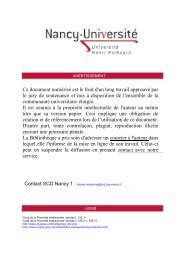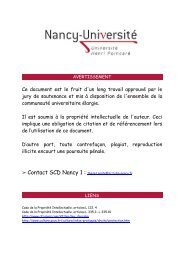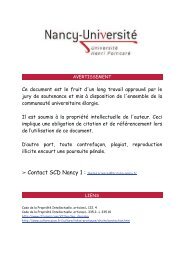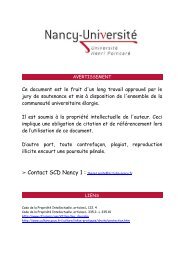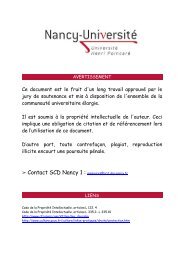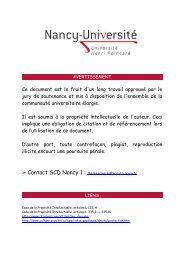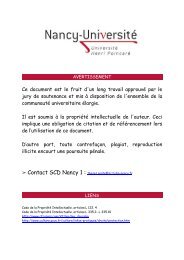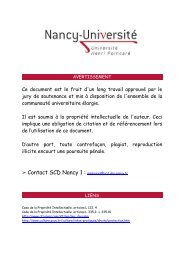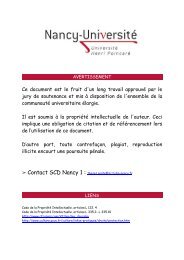Ce document numérisé est le fruit d'un long travail approuvé par le ...
Ce document numérisé est le fruit d'un long travail approuvé par le ...
Ce document numérisé est le fruit d'un long travail approuvé par le ...
You also want an ePaper? Increase the reach of your titles
YUMPU automatically turns print PDFs into web optimized ePapers that Google loves.
Peroxisome proliferator-activated receptors (PPAR) are transcription factors<br />
be<strong>long</strong>ing to the nuc<strong>le</strong>ar receptor family. Three isotypes of PPAR have been described in<br />
humans (a, NUC-1 also cal<strong>le</strong>d /3 or ù; and y). PPAR have been implicated in a variety of<br />
biological processes including colon cancer. We have studied the expression of PPAR in<br />
colonic tissues in three biological situations: during development of the human fetal dig<strong>est</strong>ive<br />
tract, in Caco-2 cells used as a model of enterocyte-like differentiation and in biopsies from<br />
tumoral and normal adjacent human colon.<br />
The PPAR subtypes are expressed as early as 7 weeks of foetus development in cell<br />
types of endoderm and mesoderm origins. The presence of PPARy protein is found by<br />
W<strong>est</strong>ern blotting and that of the encoding mRNA by nuc<strong>le</strong>ase-81 protection assay,<br />
confirming that this subtype is not adipocyte-specific. PPARa, PPAR~<br />
and PPARyexhibit<br />
different spatio-temporal patterns of expression during morphogenesis of the dig<strong>est</strong>ive tract.<br />
Whatever the stage and the gut region (except the stomach) examined, PPARy is expressed<br />
at a high <strong>le</strong>vel, sugg<strong>est</strong>ing some fundamental ro<strong>le</strong> for this receptor in development and/or<br />
physiology of the human dig<strong>est</strong>ive tract.<br />
The expression of PPARa and y was next studied in Caco-2 cells. This cell line<br />
exhibits enterocyte-like differentiation during <strong>long</strong> term culture. We showed by<br />
immunohistochemistry that both isotype protein <strong>le</strong>vels increased gradually during cell<br />
differentiation Using Nuc<strong>le</strong>ase 81 protection assay, we demonstrated<br />
that there is not a<br />
concomitant increase in the transcriptional <strong>le</strong>vel of PPAR subtypes, especially PPARa and<br />
isoforme PPARY2 which seemed to be regulated at the translational<strong>le</strong>vel.<br />
Since PPARy has been involved in human colon carcinoma, we finally inv<strong>est</strong>igated<br />
the expression of this PPAR subtype in biopsies obtained from human colon<br />
adenocarcinoma. At the transcriptional <strong>le</strong>vel, PPARy was <strong>le</strong>ss abundant in tumours than in<br />
normal-paired tissues. In contrast, using immunohistochemistry we showed that the<br />
PPARy protein amount was more abundant in tumoral tissues. In addition PPARy<br />
immunostaining was exclusively found in cytoplasm. Moreover, in normal adjacent tissues<br />
PPARy was present in the upper one-third of the crypts sugg<strong>est</strong>ing that PPARy expression is<br />
associated to the differentiation/maturation process of columnar cells.<br />
PPAR, Colorectal cancer, development, Caco-2



